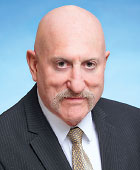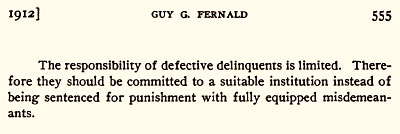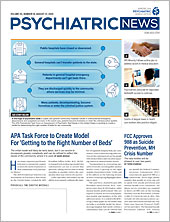The American Journal of Psychiatry (AJP) in October 1925 includes a memoriam for an APA member, Walter Fernald. Fernald was appointed superintendent of the Massachusetts School for the Feeble-Minded in 1887. He held the position until his death in 1924, and the school was subsequently named after him. The memoriam is—if you’ll allow me the expression—a whitewash. Fernald, who was as responsible as anyone in the United States for the institutionalization of people with developmental disabilities, said the following in an address to the Massachusetts Medical Society in 1912:
The feeble-minded are a parasitic, predatory class, never capable of self-support or of managing their own affairs. The great majority ultimately become public charges in some form. They cause unutterable sorrow at home and are a menace and danger to the community. Feeble-minded women are almost invariably immoral, and if at large usually become carriers of venereal disease or give birth to children who are as defective as themselves. … It has been truly said that feeble-mindedness is the mother of crime, pauperism, and degeneracy. It is certain that the feeble-minded and the progeny of the feeble-minded constitute one of the great social and economic burdens of modern times.
The July 1959 AJP includes a death announcement for Joseph deJarnette, an APA fellow who was a leading figure in Virginia’s care of people with developmental disabilities for the first 50 years of the 20th century. He was also largely responsible for the Virginia Sterilization Law of 1924, a fact mentioned in the death notice. No mention is made of his ardent struggle to expand sterilization laws to the point that in 1934, when the Nazis had an expansive eugenics program, deJarnette extolled the Virginia General Assembly to allow the sterilization of even more persons with developmental disabilities with a plea: The Nazis “are beating us at our own game and are more progressive than we are.”
Fernald did not have to worry about how he would manage Black people with developmental disabilities since 97.8% of the population of Massachusetts in 1920 was white. DeJarnette, in contrast, did have a “Black problem” since 30% of Virginia’s population was Black in 1920. How did we get to this point in history?
The first publicly funded institution for people with developmental disabilities in this country was the Experimental School for Teaching and Training Idiotic Children, opened in Massachusetts in 1848. The school was created at the urging of Samuel Gridley Howe, who wanted to prepare children with disabilities to live with the rest of society—a perspective contrary to the prevailing belief that “idiots” could not be taught. Also in 1848, Hervey Wilbur started a private school for those with developmental disabilities in Barre, Mass. In 1851 he was recruited to become the superintendent of the New York State Asylum for Idiots, the second publicly funded state school in this country for the intellectually disabled. Other private schools followed: one each in Germantown, Pa., in 1852; Albany, N.Y., in 1855; and Columbus, Ohio, in 1857. By 1876 there were seven public institutions for “feeble-minded” individuals (in order of establishment: Massachusetts, New York, Ohio, Pennsylvania, Kentucky, Illinois, and Iowa).
In 1876 in Medina, Pa., six superintendents of asylums for the “feeble-minded” met and established the Association of Medical Officers of American Institutions for Idiotic and Feeble-Minded Persons. The association’s mission was to focus on “the causes, conditions, and statistics of idiocy, and the management, training, and education of idiots and feeble-minded persons; it will also lend its influence to the establishment and fostering of institutions for this purpose.”
The institutions grew in number and size. By 1913, there were 27 public institutions for “feeble-minded and idiot” patients (Massachusetts had two, Pennsylvania had three, and New York had four). The average population of the public institutions grew from 250 in 1890 to 500 in 1910. Despite the early efforts of superintendents, these facilities shifted from focusing on habilitation to providing custodial care. This occurred in part because mainstream thinking shifted from believing that people with intellectual disabilities could be educated to believing that “feeble-mindedness” was hereditary and deterministic. Families who could afford it stayed focused on bringing out the latent talents of their intellectually disabled family member.
The growing size and number of these facilities reflected an exacerbation of negative attitudes toward people with developmental disabilities. This shift was fueled by large numbers of immigrants from Eastern Europe with “alien” names, “foreign” languages, and different customs, causing widespread fear in Americans of those who were different. This fear of perceived deviants spread to the intellectually disabled community. In 1893, Fernald made matters worse when, as president of the American Association on Mental Deficiency, he stated that institutional care was economical and conservative: “Each hundred dollars invested in institutions now saves a thousand dollars in the next generation.” Thus, the more people in institutions, the more money saved. What really sealed the melding of foreign immigrants and those with intellectual impairments were the results of the newly invented Binet IQ test administered to immigrants arriving at Ellis Island. In 1923, test scores showed that “79% of the Italians, 80% of the Hungarians, 83% of the Jews, and 87% of the Russians were feeble-minded.” Apparently, no one had questioned the cultural bias of the test.
Guy Fernald, the resident physician at the Massachusetts Reformatory, was trying to keep people with developmental disabilities out of jails and prisons. In an article in AJP in 1912, he suggested: “The responsibility of defective delinquents is limited. Therefore they should be committed to a suitable institution instead of being sentenced for punishment with fully equipped misdemeanants.” Even this, however, led to larger populations in the asylums that housed the “defective” people to whom he was referring.
Psychiatry played a crucial role in bringing Black people into this mix. As I explained in my previous columns, psychiatry endorsed and perpetuated the idea that Black people could not manage to survive in good health when left to their own devices and Black people had brains structurally incapable of higher-order thinking. Psychiatry used these concepts to explain the increasing incidence of insanity in Blacks and their growing presence in asylums for the insane. In the area of intellectual disabilities, psychiatrists explained why there were fewer Black people in institutions. In a massive four-volume tome produced in 1926 by an APA committee of six members, the authors wrote that in many states, state institutions for the insane also housed those with idiocy/imbecility/feeblemindedness/mental retardation/developmental delays/developmental disabilities.
In these institutions, there were more white than Black patients labeled as such. The prevailing belief was that even a moderate degree of intellectual impairment was noticeable in white people, while less so in Black people. Blacks were thought to have a simple nature, attending only to gratification in the moment, accepting responsibility thoughtlessly, and easily roused to happiness while unhappiness is transitory. They were also thought to be superstitious, believers in witchcraft, seldom depressed, and users of charms and herbs at puberty to bring sexual desires to fruition. No one appears to have commented that one reason there were more white patients than Black patients in Southern institutions was that Southern institutions were segregated—in this case, for whites only. Blacks were left to manage on their own.
Having explained how being Black was confused with being “feeble-minded,” we now look at how the public perception of Black people became entwined with that of immigrants. The white immigrants, who had endured long ocean voyages under awful conditions, often arrived in this country malnourished, impoverished, and physically ill. Rather than see their travails as the cause of their compromised condition, white Americans attributed it to biological inferiority. An adjective used to describe immigrants was “swarthy,” meaning dark skinned. Other adjectives included “squalid” (filthy and showing or involving a contemptible lack of moral standards) and “pestilent” (troublesome or dangerous to the morals of the public). Based on the information I provided in my previous columns on racism, it is not hard to connect the views of Americans toward immigrants with those toward Blacks.
Further, immigrants arriving at Ellis Island could be directed for a psychiatric examination based on no more than a glance of the Public Health Services screener. Those thought to be insane were marked with an “X” and “sent off the line” for a mental examination. This examination involved an oral interview and some paper tests. How these were conducted with immigrants who spoke no English is unclear.
Finally, APA and its members were contributing to prejudice and discrimination not only against Blacks, but also against anyone with psychiatric or neurological symptoms that psychiatrists said made them “degenerates.” In 1895, the editor of AJP's predecessor noted that a probate court judge in Cincinnati had announced that he would not issue a marriage license to couples when one of the parties was an epileptic. APA supported this: “If we could have more judge-made law of this kind applying to certain other incurable disease, … it might aid in repressing at least the legitimate production of degenerates.”
The judge may well have gotten his idea from psychiatrists of the era who endorsed the belief that “[t]he degenerate classes consist of idiots; cretins; imbeciles; lunatics, especially the paranoiac, maniac and dement; mutes; epileptics; choreics, chronic and congenital; athetotics, chronic and congenital; hysterics; neurasthenics; chronic criminals; prostitutes; sexual perverts; moral and spiritual perverts.” It appears psychiatrists were lumping together all individuals we would now say had developmental disabilities, serious mental illness, seizure disorders, movement disorders, and character disorders or were criminals. This made it easier for white people who thought they were mainstream “normal” to isolate so many people in asylums.
White people, fearing this mélange of Black, “feeble-minded,” insane, and foreign-born individuals, needed a solution. Greater numbers of members of these groups meant the need for more and more institutions, at higher and higher costs, and with more and more disruptions to the course of civilized society. Thus, we had the perfect storm for a new solution: eugenics. ■


